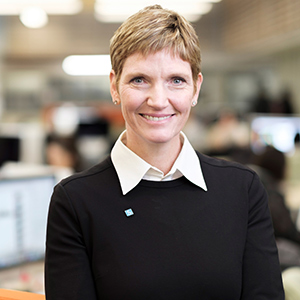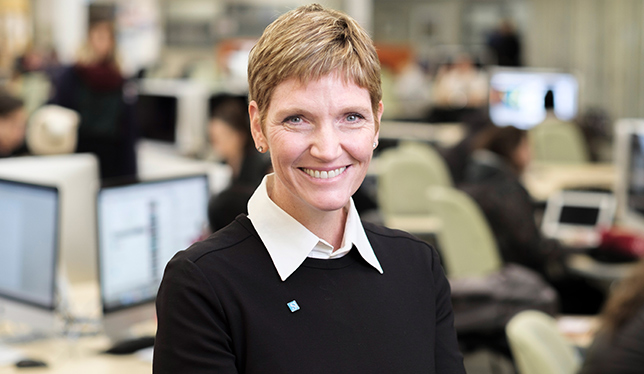After 17 years at York University, Janet Morrison stepped down from the role of vice-provost, students, last November to become provost and vice-president, academic, at Sheridan College. Dr. Morrison, who holds a PhD in higher education from Bowling Green State University in Ohio, spoke with University Affairs about what’s changed in student affairs throughout a career that spans nearly 25 years.
University Affairs: How are you feeling about leaving York?

Janet Morrison: It’s a good reminder that change is always hard. I tell students every day to think beyond the walls of their current lived experience, to think about next steps and to challenge themselves. It was time for me to think what that next step was and how I can use what the students, faculty, staff and partners at York have taught me, and try to put it to good use to expand my horizons elsewhere.
Seventeen years is a long time. It really does become your community. I have two young kids, they’re 8 and 11, and they’re so invested in the York community: they went to daycare on campus, they go to summer camp on campus, they wear York Lions Pride clothing almost constantly and they follow York teams. So it’s been hard for me and my family.
UA: What changes have you seen at York that have impacted your work in student affairs?
JM: The student demographic has changed and the obstacles to student success have escalated significantly over the last two decades. I think the opportunities for students have increased equally, but being a student is incredibly difficult — and not just because of what’s happening in classrooms, but challenges related to finances, transitions, family obligations, mental health, safety.
UA: How have you managed to push change through at York?
JM: I reject the premise that universities are stagnant, or that they’re resistant to change. Change must be carefully planned, needs to be well-championed and needs to be strategically managed. It’s also who you bring in, promote and develop. Talent is crucial and I hired specifically for change-management expertise in my office.
How we communicate change to students, faculty and staff is important. Challenges are easily navigated if you pay attention to engaging your colleagues in why the change is necessary. For me, that’s all about student voice. If you put a student in front of staff or faculty to talk about what their lived experience has been and what needs to change to enhance or optimize that experience, most people on a college or university campus respond positively.
UA: The push for more collaboration, for widespread and consistent use of data and theory seem to be new norms in student affairs. Could you speak to the evolving role of the student affairs professional?
JM: I’m forthright about my position as a white woman of privilege, a third-generation participant of the system – I mean, my grandmothers went to university, which was pretty much unheard of. When I went to university, I was a varsity athlete, I was a peer leader, I did not have to work for money, I lived on campus. When I did my graduate degree, student affairs involved developing activities around the course schedules of students who are largely living on campus, not working, and very invested in the academic experience. That’s not the typical student experience at York.
The majority of students at York work more than 26 hours a week at “part-time” jobs. Since we know that engagement is the number one predictor of student success, how do you foster engagement with students spending 90 minutes coming to and from campus every day on top of working 26 hours a week, attending courses, and possibly taking care of dependents? That’s really challenging. We’ve got to think in different ways about how we foster engagement in ways that reflect students’ lived realities.
UA: Do you see the increase of demands on students as related to a growing public opinion that university education must offer a better return on investment in terms of job outcomes?
JM: There was a time when I was hell-bent on championing the non-market benefits of engaging in postsecondary. I’ve realized over 25 years that approach is a reflection of my privilege. For the majority of the students that I support, going to university has to be marked by a market-based, personal, positive outcome.
I think the evolution of my own thinking has been that as educators, and more broadly as institutions, we need to think of a value proposition that combines the career benefits with the social, non-market benefits, and that’s a tough sell.
One of my obligations as vice-provost, students, was to share enrolment intelligence with my colleagues, specifically faculty members, to help them appreciate who our students are, what obstacles they may face, and how their definition of success varies from one to the other. Many faculty and staff think, ‘Students are just like me.’ That’s not the case.
I will forever champion attending college and university for the positive cognitive, moral, psychosocial outcomes, but I do think the academy has to embrace the fact that students are looking for personal market benefits and we’ve got to respond to that.
UA: You’re leaving York to take up a job at Sheridan College. What are you anticipating in that change from university to college environment?
JM: I’ve never really been hung up on the hierarchy between colleges and universities. If we’re truly committed to making postsecondary education accessible and to meeting student needs and expectations, then providing options that are flexible and facilitating student choice is the path forward. The hierarchy of lesser and better in terms of colleges and universities is really not helpful in that dialogue.
UA: You published an opinion piece in the Toronto Star in March last year in response to media reports of sexual and gender-based violence on campuses. In the article, you note that universities can do better and are working on improving their work to address sexual violence and support survivors, but you took issue with much of the media coverage that pitted universities against survivors. You also disclose your own experience of being stalked on campus as a graduate student. Why did you decide to speak out?
JM: If one-third of women on university campuses have experienced sexual violence, it’s not just students that have experienced violence but women on faculty and staff at these institutions too. My hope was that a personal disclosure would make that point more effectively than trying to say, ‘Stop beating us up because it’s counter-productive.’ I think to an extent, it worked.
This issue has been an ongoing concern on campuses, and society more broadly, for years and years and years. But, with recent unrelenting media coverage over the past three or four years, a picture emerged of “us versus them.” I found it unfair to the people who work at colleges and universities, and it did a disservice to survivors, too, because it suggested that there weren’t people on campus who could understand, who are empathetic, who are committed.
There are still challenges though. We’ve always done a lot on education and awareness but the imperative is for student affairs professionals, faculty and staff to think about how to influence behaviour to counter rape culture in far more purposeful, evidence-based ways. That’s ongoing work.
And we need to be mindful that this is a broader, societal issue. We seem to forget that the majority of sexual violence on campus happens within the early fall term and typically with newcomers to the campus environment. These newcomers have long been influenced by other institutions – secondary schools, peer culture – that are separate from universities. Once they are a part of our community, what are we doing to actively cultivate positive behaviours and understand what our community values are? We need to continue doing this in a way that’s evidence-based.
There’s also a delicate balance of rights and responsibilities – legal responsibilities – to both the complainant and the respondent. We often forget that alleged perpetrators are members of our community too. How well are our institutions positioned to respond in ways that respect our legal obligations to the alleged perpetrator?
Were you at all concerned that your opinion piece would be read as dismissing survivors’ concerns, or worse, trying to excuse what some were identifying as institutional failures?
JM: If we as institutions are committed to learning and human development, than we have to acknowledge when we could do better. Reflective practice matters and we have to create safe spaces where open dialogue and conversations can happen. That’s germane and fundamental to the integrity of our labelling ourselves as educators. You cannot be a good teacher if you’re not a good learner. Central to that creation of safe space though, it is not helpful if we lob volleys or choose sides.
UA: What’s kept you going in this sector for more than two decades?
JM: I boast all the time about the passion, the inspiration that’s fuelled by the opportunity to engage with students, to learn from them, and in fostering their success.
I had a conversation with a colleague at another university recently about trying to sustain that level of energy through all the negativity – when we’re reading that we don’t do a good job and we’re not responsive, that we’re averse to change – and how it is hard to stay motivated. My takeaway was that the way to do it is to stay relentlessly focused on students.
I just want to underscore what a tremendous privilege it is to play even a small part in the evolution of those bright minds. If you don’t see that, re-evaluate if this is the place for you to be. I’ll argue to my last breath though that there’s no greater calling.
This interview was condensed and edited for clarity.

Such an incredible ambassador for higher education and student affairs work in higher education. Many congratulations on this new post and may the impact of your thoughtfulness and leadership continue to grow.